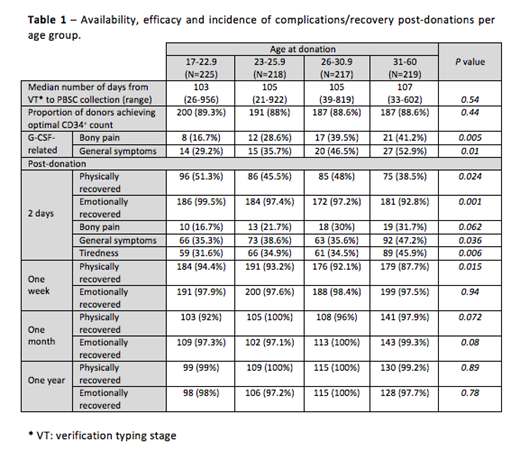Introduction
Young adults are more likely to be selected as unrelated stem cell donors because younger donor age has been associated with improved overall survival for recipients. Younger donors are also less likely to have co-morbidities leading to cancellation at the donor medical.
Due to this, donor recruitment policies target the young adult population, and in 2012 the Anthony Nolan Bone Marrow Registry lowered the recruitment age for donors from 18 to 16 years.
Previously published studies of unrelated donor recovery and experience have not included donors under 18, and have included relatively low proportions of young adult donors. The aim of this study was to compare donor availability, stem cell yield, and recovery across donor age groups.
Methods
All sequential first peripheral blood stem cell (PBSC) donations to adult patients from unrelated donors at the Anthony Nolan Registry between May 2015 and September 2017 were analysed (n=879).
The primary outcome was achievement of optimal collection yield (CD34+ ≥4x106 cells per kg patient weight) following 4 or 5 days of G-CSF (depending on whether 1 or 2-day collection were required). The secondary outcomes were turnaround time from verification typing stage to donation (to assess donor availability), and the incidence of complications post-donation (skeletal pain, general symptoms and emotional state) as well as self-reported recovery.
Donors were grouped in age-based equal quartiles (17-22.9, 23-25.9, 26-30.9 and 31-60 year-old). Groups were compared using the chi-squared test, or chi-squared trend test for categorical variables, and the Kruskal-Wallis test for continuous variables. Follow-up data was collected prospectively via online questionnaires post-donation at day 2, day 7, day 30 and 1 year.
Results
Results by age group are presented in Table 1.
There were no differences in the proportion of donors achieving the optimal CD34+ count (p=0.44) between the different age groups, regardless of the number of collection days required. Furthermore, no differences were found in the turnaround time from the verification typing stage to stem cell collection between younger and older donors (p=0.54).
During G-CSF administration, older donors were more likely to suffer from bony pain (p=0.005) and general symptoms (such as anorexia, tiredness or night sweats) compared to younger donors (p=0.001).
Two days post-collection, a higher number of younger donors reported emotional (p=0.001) and physical recovery (p=0.024) compared to older donors. Also older donors experienced more general symptoms after donation (p=0.036), and tiredness was particularly more prevalent among older donors at this time point (p=0.006). There was a trend in older donors reporting more bony pain than younger donors (p=0.062).
One week after donation, there was a higher physical recovery rate in younger donors (p=0.015).
Longer-term recovery did not differ by age.
Conclusions
Younger donors proceed to donation as quickly as older donors, and are equally effective in achieving the stem cell yield. Younger donors report fewer complications and experience a faster physical and emotional recovery following PBSC donation. In addition, G-CSF has a favourable side effect profile on this population.
These results support recruitment of unrelated donors from 16 years of age and suggest that our current registry pathway for support of these donors is adequate. Follow-up is fundamental to address medical or psychological issues, and manage them accordingly, mainly within the first week post-donation and particularly in older donors.
No relevant conflicts of interest to declare.
Author notes
Asterisk with author names denotes non-ASH members.


This feature is available to Subscribers Only
Sign In or Create an Account Close Modal